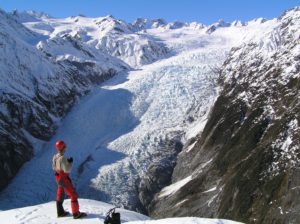An unusual period where some of New Zealand’s glaciers grew bigger, despite a trend of shrinking glaciers worldwide, was due to a series of unusually cold years, according to new research.

At least 58 New Zealand glaciers advanced between 1983 and 2008, with Franz Josef Glacier advancing almost continuously during this time. It has been thought that increased rainfall was the cause of the anomaly, but a new study from Victoria University of Wellington and Niwa scientists has found a run of cooler years was the likely cause.
Their study, published today in Nature Communications, showed that despite the unusual growth – the glacier behaviour was consistent with human-caused climate change. Lead author Associate Professor Andrew Mackintosh said the future “doesn’t look good” for NZ glaciers.
“New Zealand’s glaciers are very sensitive to temperature change. If we get the two to four degrees of warming expected by the end of the century, our glaciers are going to mostly disappear. Some may experience small-scale advance over that time due to the regional climate variability, but overall they will retreat.”
The SMC gathered expert reaction on the article, please feel free to use these comments in your reporting. More information about the study is available on scimex.org.
Dr Heather Purdie, glaciologist, University of Canterbury, comments:
“The research by Mackintosh et al. further confirms our understanding about how important temperature change is to New Zealand glaciers.
“Previously we have tended focused on the impact that very warm years have on negative glacier mass balance. For example, my work on Rolleston Glacier, where we discovered that one very warm year can remove up to five years of previous snow accumulation from that glacier. Likewise, previous work I did looking at snow accumulation patterns on Tasman Glacier also identified a strong correlation between sea surface temperature in the Tasman Sea and net snow accumulation on this glacier.
“Net accumulation is how much snow is left at the end of summer to be used to nourish the glacier. What is new in this latest paper is that they have also demonstrated the importance of temperature to positive glacier mass balance. It is not just the warmer years that are important, but also the cooler years, and they have linked these patterns of climate variability to large-scale atmospheric circulation patterns that we had not previously given much attention to in the New Zealand region.”